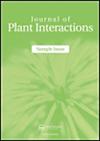Bicarbonate uptake experiment show potential karst carbon sinks transformation into carbon sequestration by terrestrial higher plants
IF 3.3
3区 生物学
Q2 PLANT SCIENCES
引用次数: 4
Abstract
ABSTRACT Karstification forms tremendous karst carbon sinks in the Earth. Whether terrestrial higher plants can absorb and utilize bicarbonate, there is a key testimony that karst carbon sinks can be transformed into carbon sequestrations by terrestrial higher plants. The uptake and use of root-derived bicarbonate, photosynthesis, phosphoenolpyruvate carboxylase and ribulose-1,5-bisphosphate carboxylase contents of Broussonetia papyrifera (Bp) and Morus alba L. (Ma) were measured. This study provides the most direct and primary evidence for the transformation using the bidirectional isotope tracer technique. The transformation may result from the synergism in the absorption and utilization of photosynthetic and nonphotosynthetic pathway, and simultaneously strengthen karst carbon sink and carbon sequestrations of plants, while it had no effect on photosynthetic CO2 assimilation in leaves. Differences in the transformation result in the discrepancies of Bp and Ma in the adaptation to karst environments. Karst-adaptable plants can more regulate the entire carbon cycle.碳酸氢盐吸收实验表明,陆地高等植物有可能将岩溶碳汇转化为固碳
岩溶作用在地球上形成了巨大的岩溶碳汇。陆地高等植物能否吸收和利用碳酸氢盐,有一个关键的证据表明,岩溶碳汇可以被陆地高等植物转化为碳封存。测定了构树(Bp)和桑树(Ma)对根源碳酸氢盐的吸收和利用、光合作用、磷酸烯醇丙酮酸羧化酶和核酮糖-1,5-二磷酸羧化酶的含量。这项研究为使用双向同位素示踪技术进行转化提供了最直接和最初步的证据。这种转化可能是光合和非光合途径吸收和利用的协同作用,同时增强了植物的岩溶碳汇和固碳作用,而对叶片的光合CO2同化没有影响。转换的差异导致Bp和Ma在适应岩溶环境方面的差异。岩溶适应性植物可以更好地调节整个碳循环。
本文章由计算机程序翻译,如有差异,请以英文原文为准。
求助全文
约1分钟内获得全文
求助全文
来源期刊

Journal of Plant Interactions
PLANT SCIENCES-
CiteScore
5.30
自引率
6.20%
发文量
69
审稿时长
>12 weeks
期刊介绍:
Journal of Plant Interactions aims to represent a common platform for those scientists interested in publishing and reading research articles in the field of plant interactions and will cover most plant interactions with the surrounding environment.
 求助内容:
求助内容: 应助结果提醒方式:
应助结果提醒方式:


